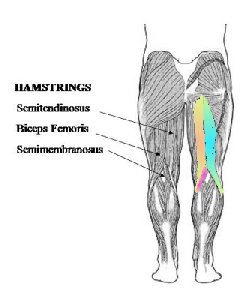This entry discusses healthy hamstring movement, exercises to free tight hamstrings, and some of the consequences of tight hamstrings. Resources to a hamstring stretch substitute that produces superior results by retraining muscle/movement memory and to programs to improve agility appear at the end.
To free tight hamstrings, it’s important to understand their four movement functions and then to get free control of those movement functions.
- leg extension at the hip joint
- leg flexion at the knee
- rotation of the lower leg at the knee joint
- stabilization of the pelvis when bending forward
We must free them (gain control of tension and relaxation) in all four movement functions.
If we do not gain (or improve) control in all four movement functions, one or more of those movement habits will dominate control of the other movement(s).
In addition, the hamstrings of one leg work alternately with those of the other — as in walking; when the hamstrings of one leg are bending or stabilizing the knee, the hamstrings of the other leg are extending or stabilizing the other leg at the hip. In those movements, the hamstrings coordinate with the hip flexors  and psoas muscles. (Co-contraction of hamstrings and hip flexors/psoas muscles leads to hip joint and ilio-sacral (SI) joint compression.) So our approach (being movement-based) must take those relationships into account. Otherwise, we never develop the feeling of free hamstrings in their familiar movements and return habitually to their tight state which, because it feels familiar, feels “normal”.
and psoas muscles. (Co-contraction of hamstrings and hip flexors/psoas muscles leads to hip joint and ilio-sacral (SI) joint compression.) So our approach (being movement-based) must take those relationships into account. Otherwise, we never develop the feeling of free hamstrings in their familiar movements and return habitually to their tight state which, because it feels familiar, feels “normal”.
The Four Movements of Hamstrings
LEG EXTENSION AT THE HIP JOINT
That’s the “leg backward” movement of walking. The hamstrings are aided by the gluteal (butt) muscles, but only in a stabilizing capacity. The major work is done by the hamstrings. In this movement, the hamstrings, inner and outer, work together in tandem.
LEG FLEXION AT THE KNEE JOINT
That’s the “getting ready to kick” movement and also the “pawing the ground” movement. In these movements, the hamstrings, inner and outer, also work together in tandem (same movement).
To the anatomist and kinesiologist, it may seem incomprehensible (“paradoxical”) that the hamstrings are involved in both movements — leg forward and leg backward — but that’s how it is. Though the hamstrings are involved in both cases, different movements cause a different feel.
LOWER LEG ROTATION AT THE KNEE
That’s the turning movement used in skating and in turning a corner. In this movement, the inner hamstrings (semi-membranosis and semi-tendinosis) relax and lengthen as the outer hamstring (biceps femoris) tighten to turn toes-out and the inner hamstrings tighten to turn toes-in as the outer hamstring relaxes and lengthens.
STABILIZATION OF THE PELVIS WHEN BENDING FORWARD
The hamstrings anchor the pelvis at the sitbones (ischial tuberosities) deep to the ‘smile’ creases beneath the buttocks (not the crack), so one can bend forward in a controlled way, instead of flopping forward at the hips like a marionette. In this movement, the hamstrings coordinate with the front belly muscles (rectus abdominis).
In most people, either the rectus abdominis or hamstrings dominates the other in a chronic state of excessive tension, so freeing and coordinating the hamstrings involves coordinating and matching the efforts of the two muscle groups. When the hamstrings dominate, we see swayback; when the rectus muscles dominate, we see flat ribs.
Training Control of Tight Hamstrings

When training control of tight hamstrings (to free them), it’s convenient to start with the less complicated movement, first. That’s the anchoring movement that stabilizes bowing in a standing position. To see an exercise that cultivates hamstring control this way, click here.
After we cultivate control of “in tandem” hamstring movements (movement in which the hamstrings are doing the same action — lengthening, shortening or turning the lower leg), we cultivate control of “alternating” hamstring movements. To see an exercise that cultivates hamstring control this way, click here. (That link opens an email window to request a preview of The Magic of Somatics, an instructional book of somatic exercises. The preview contains the somatic exercise we are discussing.)
By cultivating control of “in tandem” and “alternating” movements, we fulfill the requirements of functions (1.), (2.), and (4.). The exercise linked in the paragraph above indirectly addresses function (3.) (lower leg rotation at the knee).
Merely to develop this kind of control is sufficient to free tight hamstrings. It’s lack of free control of the movements I have described, in which automatic postural reflexes cause tight hamstrings, that lead to many common knee injuries (including meniscal tears and chondromalacia patelli) and common hamstring pulls or tears experienced even by athletes who stretch.
One more thing: tight hamstrings go with tight back muscles. They’re reflexively connected. So if you have tight back muscles, back pain, or even back spasms, you may need to address both your hamstrings and your back muscles. As a runner, you’ll find that to do so improves your stamina, breathing, and time.
Two programs that provide those benefits appear below. Free previews are available and you’re invited to take advantage of them.
Programs That Have Somatic Exercises that Free Tight Hamstrings
Other exercises that have this effect exist in the somatic exercise programs, “Disproving the Myth of Aging” and “Free Your Psoas”, for which previews exist through the links, above.
MORE:
How Tight Hamstrings
Cause Knee Damage
and a better way to free them

